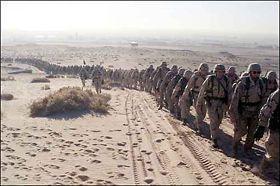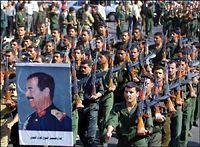 |
 |
| COLIN WYERS / GETTY IMAGES |
| U.S. Marines from the 1st Marine Expeditionary Force march toward Camp Commando on Dec. 31 in Kuwait. The Marines were making their way up Mutla Ridge during the seven-mile walk to their forward camp. |
 |
THE U.S. MILITARY
Cutting-edge weaponry eclipses even that used in the Gulf War.
Before leaving Iraq in 1998, United Nations weapons inspectors tagged equipment they thought needed to be destroyed, including some that may have been used for legitimate civilian purposes but could be converted for use in making biological weapons. That exercise has paid off as a second group of U.N. inspectors combs the country for evidence that Saddam Hussein has weapons of mass destruction.
U.S. military capabilities have become more high-tech, more precisely deadly than they were when U.S. forces fought Iraqi troops in the 1991 Gulf War.
The so-called "smart weapons" that dazzled observers of the Gulf War did not work well in clouds or dust. Now, the United States has satellite-guided weapons that can operate in any weather.
New versions of the Tomahawk cruise missiles first used in that war use satellite guidance as well and have the ability to change targets in minutes.
B-2 bombers, used in Afghanistan, would likely be used during the first hours of war to soften up defenses. Drones were used during the Gulf War as decoys during air assaults. High-flying Global Hawk drones would be called on to track troop movements from the air. Low-flying drones would also be used. Last year a Predator operated by the CIA was used in Yemen to wipe out a vehicle carrying al-Qaida operatives.
The Patriot-2 missiles used to protect vital installations have been upgraded but not much changed since 1991. Patriots were not effective against Iraqi Scud missiles in the Gulf War — they actually intercepted and shot down few of the clumsy Scuds.
SEARCH FOR SCUDS
In 1991, the U.S. fruitlessly initiated more than 2,000 missions to find and destroy the mobile launchers and missiles, according to Time magazine.
This time, the U.S. has better intelligence about where to find them, and Israeli units have been conducting reconnaissance missions in western Iraq, looking for likely launch sites near possible hiding places.
Computer capabilities have changed since 1991 — Air Force and Navy computers couldn’t talk to each other during the Gulf War and target lists had to be flown to aircraft carriers then.
As for manpower, the exact size of the deployment to the region isn't known, but about 250,000 troops were sent to the Gulf War. Two aircraft-carrier battle groups and hundreds of combat aircraft have been at the ready since the first of the year for what could be an intense air and ground assault from the south, north and west.
Thousands of military personnel have been deployed to bases in Saudi Arabia, Qatar, Oman, Bahrain and other locations in recent weeks. Some are combat-ready, including infantry units, officials said.
Many more are members of logistics, engineering and support teams, needed to prepare for the arrival of the larger combat units.
The Iraqi military
Saddam's ability to battle any invasion might hinge on what lies hidden in his arsenal.
 |
 |
| TAHA AL-RUBAYYH / GETTY IMAGES, 2002 |
| Iraq's military can still muster a parade, but it faces long odds in a fight against U.S. troops should an invasion occur. |
 |
The war clouds gathering over Iraq are likely to rain ordnance mostly marked Made in America.
Unless Saddam Hussein seeds the sky with chemical or biological warfare — as experts say he may since he may have nothing left to lose — the war is likely to be decidedly one-sided.
Saddam has maintained he has no programs to develop chemical and biological weapons of mass destruction, no nuclear-weapons program and no desire to rebuild his arsenals.
But a congressional resolution last fall authorizing President Bush to go to war against Iraq stated that it has sizable stockpiles of chemical weapons, a large-scale biological-weapons program and a nuclear-weapons program that was much closer to producing a bomb than previously believed.
Iraq claimed to have 10,000 chemical weapons after the Gulf War — a figure disputed by inspectors, who said it was 10 times that. Iraq can make mustard gas and reportedly has large stores of biological agents including concentrated botulinum toxin — which in aerosol form kills by paralyzing the respiratory muscles — and anthrax spores.
It's also possible Saddam has retained samples of smallpox virus from a naturally occurring outbreak in Iraq in the 1970s, and he might have stores of the organism that causes plague.
MISSILES REQUIRED
But chemical and biological weapons won't do him any good unless he has the missiles to deliver them. The U.N. sanctions after the Gulf War forbade him having any missile with a range of more than 100 miles.
But in 1998, Iraq admitted having 25 biological warheads for Scud missiles, which can travel well beyond 100 miles, and U.S. intelligence experts believe it kept 24 hidden Scuds when U.N. inspectors left in 1998.
Dozens of suppliers, most in Europe, the U.S. and Japan — wittingly or not — provided the components and know-how Saddam needed to build an atomic bomb, according to Iraq and U.N. officials.
According to Gary Milhollin, director of the Wisconsin Project, a Washington, D.C.-based think tank on nuclear-arms control, if it hadn't been for the Gulf War, Iraq would now have nuclear weapons.
As for troop counts, Iraq stands to be woefully outmanned in this confrontation.



